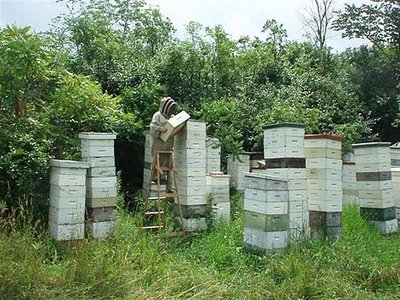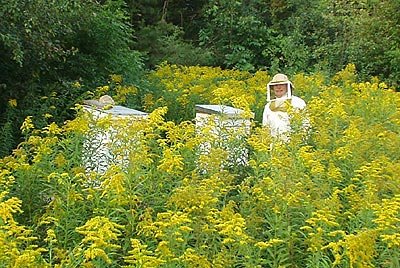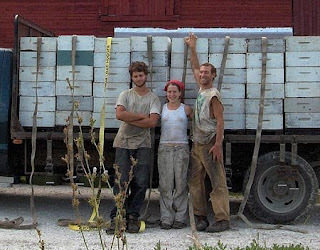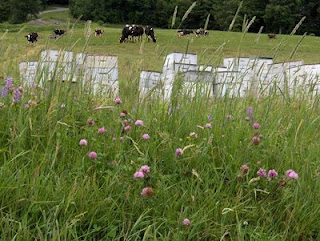a relationship with the bees and plants

I have found that when dealing with nature, if one is to adopt a faithful mentality, the wild forces drive what is needed to those places of wanting. For a year I had the desire to know my own bees and to have a colony to watch collect nectar. All of this came about in the early summer of this year. Todd and I were eating breakfast outside at the honey house before a day’s work. He had left to retrieve the oatmeal as my head seemed to clear with a buzz in the air. When I recognized the flying noise, I dismissed it for the usual noises of a honey farm. I began to notice a cloud of sweet insects scouting around before the larger wave of bees encapsulated me. I sat quietly, still, and somewhat cautious as I did not understand what was happening. I felt in the center of a living, breathing organism it was a fragile and potent creature that surrounded me. I was being sheltered by a mass of over 10,000 bees. Todd came out with the oatmeal, hands stretched out in amazement, exclaiming as he joined me in nature’s embrace, “Joe, this is a swarm! We’re in a swarm.” He showed me how gentle they were by walking though them. We found that they were making their new home in some old beeswax frames. They were a mass of pollinators looking for a dark place, furnished with the remnants of their past generations. “See how gentle they are”, Todd said, as he gave them frames of young bees from an established colony nearby in order to in sure that the swarm would stay in their new home. We watched them for while in silence, without any bee veils or a smoker.
“These bees have come to you, Joe”, Todd took on a prophetic tone, “we have talked about this, and I think it is time they have come to be with you.” He asked me if I wanted to accept the colony as my own. I looked at him, then back at the bees and gave the nod of a child in agreement.
The bees are now working at their own pace, on nature’s calendar in Monkton, Vermont. We brought them there to my high school, the Walden Project, in hopes of sharing these creatures with my peers.
Burdock is a rank weed to many people.
I know lots of gardeners and farmers and dog owners who curse the spread of their burrs. Yet in China and Japan burdock is revered in cooking, blending into the combination of food and medicine. Among herbalists the plant is known for its medicinal power of supporting the liver and cleansing the blood. At Honey Gardens we use organic burdock in our Rejuvenation Tonic. It seems that fighting this plant would be exhausting and trying to control the burrs would prove relentless. Several years ago on a beautiful afternoon in early September I was hanging out with this burdock plant up in Elmore. I took one of the brown burrs and opened it up and counted the seeds. I counted 70 seeds in one burr and 249 burrs on one plant for a total potential of 17,430 seeds on one plant ! I was in awe. I was in awe. That is quite a will to survive. Anything with a life force that profound I want to know it, to be around it, nourish myself with it, to learn from it, and to have it part of my daily life.
The gifts from plants and nature are sacred and require honor and celebration. Plants can teach us many lessons that life in our present day culture cannot. We can learn a lot from listening to their expressions and observing their marvelous beauty. In this journey with plants I learn how to open my heart and quietly listen. I learn when I am too attached to my version or expectations of an outcome. How to sit in quite beauty. How to ask myself what is really important in this life. Whether it is the generous gift of medicine in the root or the fruit, the stunning color of a flower, or the nectar and pollen that clings to the bees, plants teach us to celebrate the moment, the gift of life we hold in our hands.
The journey is together and the dynamic forces of life are always changing. I get a delicious feeling of vitality in early summer when the dandelions release their seeds on the wind and the sky seems to fill with a light snow. There goes next year’s medicine and glorious yellow flower. Where will they land?



